York's Old Railways
Last updated 29th January 2023
Cycling in Yorkshire

Last updated 29th January 2023

I became interested in the old railways around York when I was researching and writing Bike Rides In and Around York.
Some of the routes in the book are on old railways. Others run close to disused railways that were once very important to local trade and travel.
The trackbeds of these railways are marked on Ordnance Survey maps, and they are often visible on the ground if you know where to look. On the other hand, on the maps and on the ground the old railways are easily overlooked, and in many cases they seem to be gradually fading into invisibility.
These are some of the old railways shown on the map (main image at the top of the page) and mentioned in Bike Rides In and Around York.

The York & Doncaster Branch opened in 1871.
Local trains ran between York and Doncaster, via Selby and other minor stations; the minor stations closed in the 1950s and 1960s.
This railway was also part of the East Coast Mainline. British Coal paid for it to be diverted (the Selby Diversion) so that they could open and work the Selby Coalfield under the York & Doncaster Branch. The diversion opened in 1983.
Sustrans bought the York to Riccall section of the York & Doncaster Branch, and used it to create the Solar System Cycleway.

The Foss Islands Branch Line was a 2-mile line that opened in 1880, and linked the York-Scarborough line to the Derwent Valley Light Railway (DVLR) terminus in Layerthorpe.
It largely carried freight to and from the Rowntrees factory on Haxby Road, and stayed open until 1989. It now forms part of the Derwent Valley & Foss Islands Cycle Track, which goes from the B1363 to Metcalfe Lane, Osbaldwick.
The Derwent Valley Light Railway opened in 1913, and ran east from Layerthorpe to Dunnington, then south towards Cliff Common, near Selby.
The DVLR was an agricultural railway that always remained independent.
It also ran blackberry-picking specials to Skipwith Common, which gave it the nickname the Blackberry Line.
The DVLR closed in 1981, although a short section has been revived as part of the Yorkshire Museum of Farming at Murton Park.
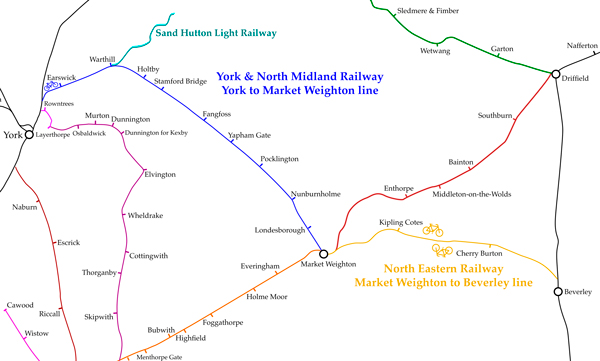
George Hudson's York & North Midland Railway (YNMR) was the first to reach Market Weighton, building a line from York which opened in 1847.
Hudson fell from grace in 1848 when he was accused of fraud. Partly because of that, but also because landowner Lord Hotham refused permission for a railway across his land, the extension to Beverley was delayed for a number of years.
The successor company to YNMR, North Eastern Railway, built a single track line from Market Weighton to Beverley in 1865, appeasing Lord Hotham by giving him his own station (Kipling Cotes).
Trains stopped running on the York to Beverley line in 1965, and Market Weighton station closed in the same year.
The Sand Hutton Light Railway served the estate of Sir Robert Walker, 4th Baronet of Sand Hutton, and carried coal, bricks and agricultural produce.

One small part of the York to Market Weighton line is used for cycling - the path across Bootham Stray linking the old Rowntrees/current Nestlé site to New Earswick.

The trackbed between Market Weighton and Beverley is now a bridleway called the Hudson Way Rail Trail, suitable for mountain biking.
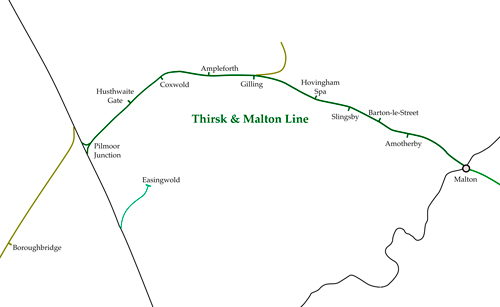
The Thirsk & Malton line was built by the York, Newcastle & Berwick Railway, and opened in 1853.
It was a single track, built at roughly the same time as the Malton & Driffield Railway, and designed to link to it.
The two lines carried coal, animal feed, timber, and limestone from quarries along the Malton & Driffield Railway.
A branch from Gilling to Helmsley was built by North Eastern Railway in 1871, and extended via Kirby Moorside to Pickering by 1875.
From 1895 to 1923 there was a horse-drawn tramway from Gilling Station up to Ampleforth College, taking coal to the college for the production of coal gas, as well as transporting staff and pupils.
The Thirsk & Malton line closed in 1964.
There is a miniature railway at Gilling East, run by members of the Ryedale Society of Model Engineers.

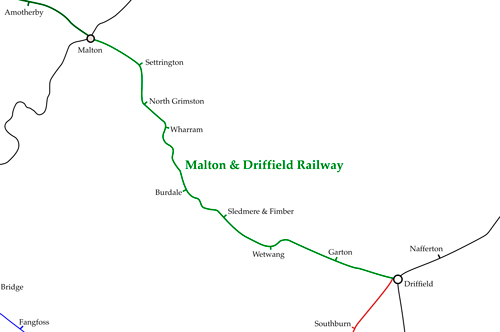
Work on the Malton & Driffield Junction Railway began in 1847. George Hudson helped finance the project, and Charles Dickens' brother Alfred was one of the engineers. It was initially envisaged as a double track, but due to financial problems the plans were changed to build just a single track. The line was finished in 1853.
In 1854, the Malton & Driffield Junction Railway became part of the successor company to Hudson's York & North Midland Railway, the North Eastern Railway.
The passenger service on this line was known as 'the Malton Dodger'.
Freight on the line included barley, oats, timber, livestock and coal. The trains also transported stone from various limestone quarries along the route, and from a chalk quarry by Burdale Station. The mile-long tunnel at Burdale is now a bat hibernaculum.
The line closed in 1958, but more recently a group of enthusiasts set up the Yorkshire Wolds Railway near Fimber. It is a heritage attraction that opened around 300m of track in 2015, and plans to expand.

These lines were planned during the period of railway mania.
George Hudson's York & North Midland Railway completed the single track line from Selby (Barlby Junction) to Market Weighton in 1848. By 1866 there were four daily trains between Selby and Market Weighton.
The North Eastern Railway built the line from Market Weighton to Driffield, which opened in 1890.
Stations started closing in 1953, and the whole of both routes was defunct by 1965.

You can cycle part of the Selby to Market Weighton line. It's a bridleway called the Bubwith to Market Weighton Rail Trail, and it runs for 8 miles.
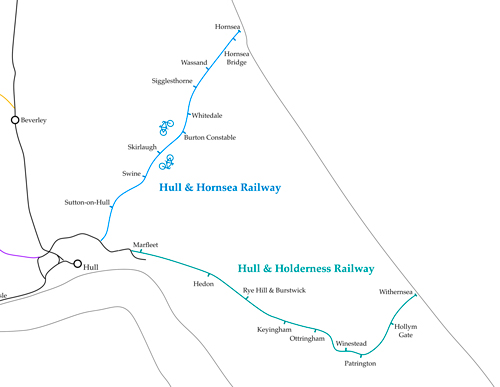
Hornsea resident and Hull timber merchant Joseph Wade promoted the line from Hull to Hornsea. He cut the first sod in 1862 with a silver spade, and the railway opened in 1864.
The line closed in 1965 during the Beeching cuts. It is now the Hull to Hornsea Rail Trail.
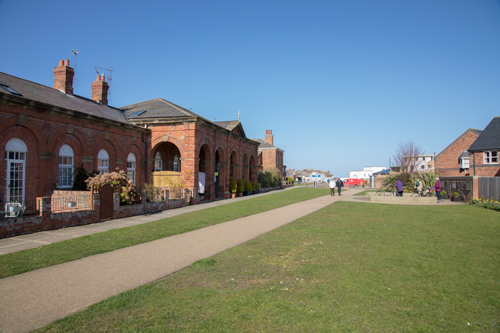
The Hull & Holderness Railway was promoted by Hull businessman Anthony Bannister, and opened in 1854. It began at YNMR's Victoria Dock station in Hull and ended at the Station Hotel in Withernsea.
This line partly closed in 1965, but good trains ran between Hull and Marfleet until 1972.
Parts of the line are now bridleway, but there isn't a complete rail trail from Hull to Withernsea.

This railway opened in 1885 and had a very long name, which can be shortened to the Hull & Barnsley Railway. You can see a full route map here.
It was intended to maintain Hull's prosperity as a port, by breaking NER's monopoly, and stopping NER diverting trade to other ports including Hartlepool, Goole and Grimsby.
The easy route into Hull along the Humber had already been taken by NER, so the Hull & Barnsley line had to tackle the Wolds, which meant expensive tunnels.
Station closures began in 1932, and the whole line closed in 1964.
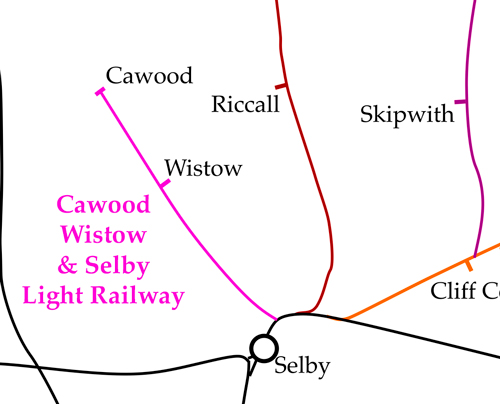
The Cawood, Wistow and Selby Light Railway opened in 1898. It ran to a platform at Brayton Gates in Selby.
The passenger service started out as five trains a day, and the journey time was 17 minutes. Visiting Selby Market was one of the reasons people travelled on this railway. Goods trains transported agricultural produce like potatoes and beet.
Road transport replaced rail, and the line closed in 1960. Wistow Station still exists as a private house.

Church Fenton to Harrogate was a YMNR line, which opened in 1847-8.
It came into Harrogate through the Prospect Tunnel then over the Crimple Viaduct. The Harrogate terminus was Brunswick Station, and it wasn't until 1862 that NER built the present-day Harrogate station in the town centre.
The line closed in 1966 during the Beeching Cuts. The Leeds & Thirsk Railway line, which originally went via Starbeck, now uses YNMR's line over the Crimple Viaduct into Harrogate.
The part of the line between Spofforth and Newton Kyme is now the Harland Way.
The Cross Gates to Wetherby line was opened by NER in 1876, intially as part of a plan for a new Leeds to Scarborough route (never completed).
The Cross Gates to Wetherby line meant there was an alternative to the Leeds & Thirsk route for passengers travelling between Leeds and Harrogate.
The line closed in 1964.
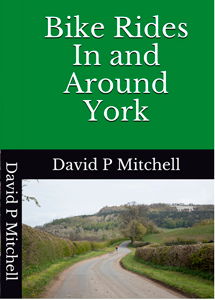
The York, Selby and Church Fenton road bike ride is one of the eighteen routes in the book Bike Rides In and Around York.

